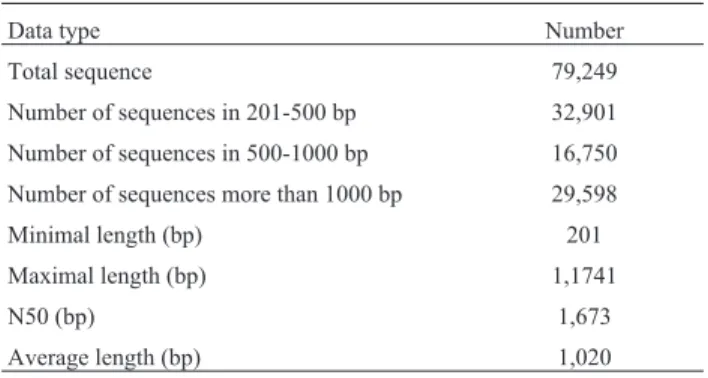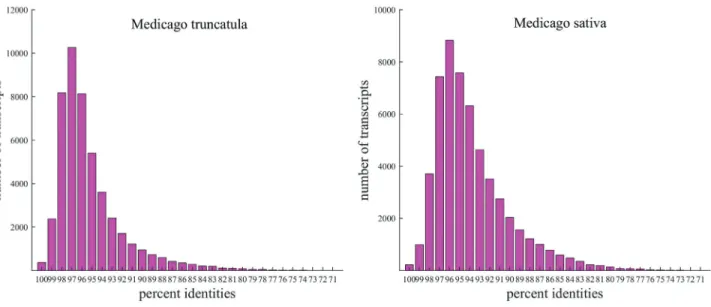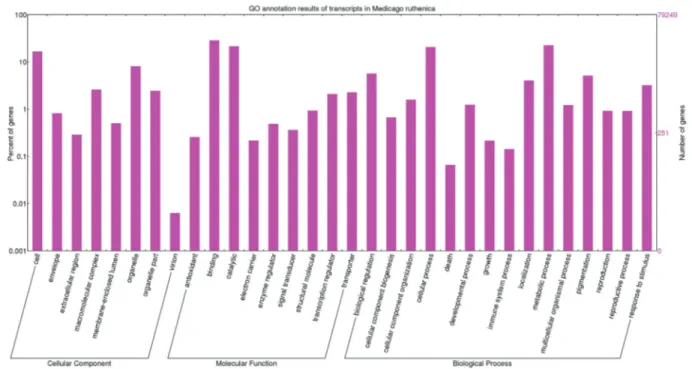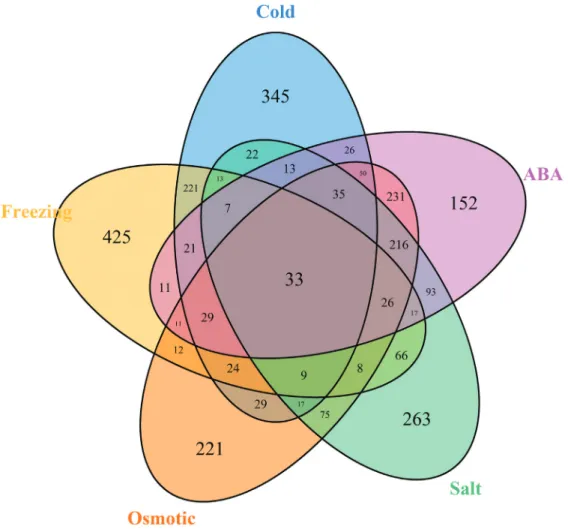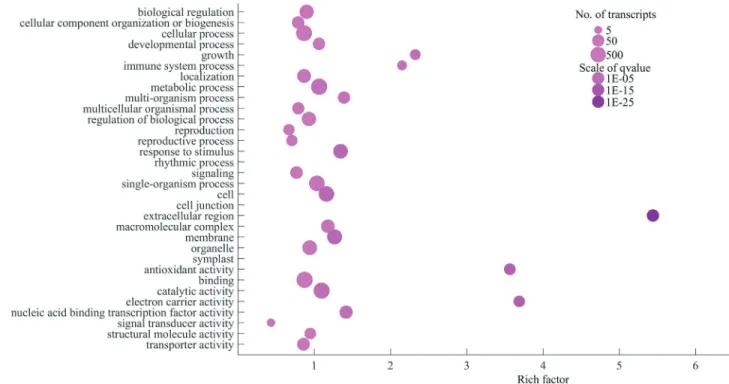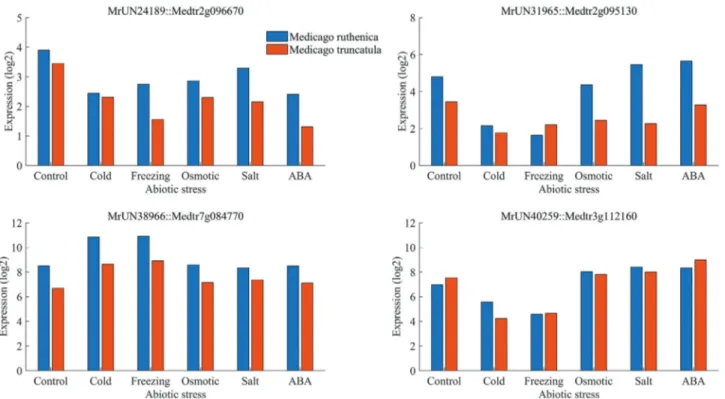Transcriptome sequencing and expression profiling of genes involved in the
response to abiotic stress in
Medicago ruthenica
Yongjun Shu
1, Wei Li
1, Jinyue Zhao
1, Ying Liu
1and Changhong Guo
11
College of Life Science and Technology, Harbin Normal University, Harbin Heilongjiang, China.
Abstract
Medicago ruthenica is a perennial forage legume with the remarkable ability to survive under unfavorable environ-mental conditions. It has been identified as an excellent species ofMedicago that can adapt to various environmental stresses including low temperature, drought, and salinity. To investigate its potential as a genetic resource, we per-formed transcriptome sequencing and analysis inM. ruthenica under abiotic stresses. We generated >120 million reads from six cDNA libraries, resulting in 79,249 unique transcripts, most of which were highly similar to transcripts fromM. truncatula (44,608, 56.3%) and alfalfa (M. sativa, 48,023, 60.6%). Based on gene expression profiles, 2,721 transcripts were identified as abiotic stress responsive genes which were predicted to be mainly involved in phytohormone signaling pathways, transcriptional regulation, and ROS-scavenging. These results suggest that they play critical roles in the response to abiotic stress. In summary, we identified genes in our transcriptome dataset in-volved in the regulation of the abiotic stress response inM. ruthenica which will provide a valuable resource for the fu-ture identification and functional analysis of candidate genes for adaption to unfavorable conditions. The genes identified here could be also useful for improving stress tolerance traits in alfalfa through molecular breeding in the fu-ture.
Keywords:Medicago ruthenica; RNA-Seq; transcription factor (TF); abiotic stress; reactive oxygen species (ROS).
Received: October 9, 2017; Accepted: January 3, 2018.
Introduction
In the natural environment, plant growth is often neg-atively affected by various unfavorable environmental con-ditions, such as temperature extremes, drought, and soil salinity. Unfavorable environments have selected for plants that can extensively modify their physiological and bio-chemical status to adapt to abiotic stresses, and these pro-cesses are controlled by complex regulatory networks involving numerous genes (Chinnusamy et al., 2004). Based on their roles in response to stress, the genes are clas-sified into two major functional groups: the first group is mainly comprised of genes encoding osmoprotectants, heat shock proteins (HSP), late embryogenesis abundant pro-teins (LEA) (Cuevas-Velazquezet al., 2014), transporters (Dos Reiset al., 2012), antioxidants (such as peroxidase, superoxide dismutase, and glutathione peroxidase) (Gill and Tuteja, 2010) and various kinds of metabolism-related proteins. These functional genes play important roles in protecting plants from the effects of environment stress. The second group is made up of genes involved in signal
transduction and transcriptional regulation, a good example being transcription factors (TFs) that function by regulating the expression or status of other genes. At present, numer-ous TFs, such as members of the AP2/ERF, MYB, and NAC families, have been identified and characterized as being important regulators in the abiotic stress response in model plants (Golldack et al., 2011; Chen et al., 2012; Mizoiet al., 2012).
Medicago ruthenica L. is an allogamous, diploid (2n=16) perennial legume forage crop that is widely dis-tributed in Siberia, Mongolia, and northern China. Because of its high tolerance to various extreme environmental con-ditions, including low temperatures (cold and freezing), drought, and salinity (Campbell et al., 1997; 1999), Balabaev (1934) noted that M. ruthenica has excellent prospects as a new forage species, and Campbell et al.
(1999) positively evaluated its potential application in low input systems. Wanget al.(2008) hybridizedM. ruthenica
withM. sativa, and produced a new alfalfa cultivar (M. sativacv. `Longmu No.3’) with high tolerance to freezing stress, which suggested thatM. ruthenicacan provide valu-able genes for the genetic improvement of alfalfa through breeding. Both Yanget al.(2011) and Guanet al.(2009) in-vestigated the physiological and biochemical responses of
M. ruthenica to abiotic stresses, and their results have shown that this species is able to regulate its photosynthetic
DOI: http://dx.doi.org/10.1590/1678-4685-GMB-2017-0284
Send correspondence to Yongjun Shu and Changhong Guo. Col-lege of Life Science and Technology, Harbin Normal University, No. 1 of Shida Road, 150025, Harbin, Heilongjiang, China. E-mail: syjun2003@126.com (Yongjun Shu), kaku_2008@163.com (Changhong Guo).
rate, stomatal conductance, and CO2concentration to
im-prove its tolerance to various stresses. However, M. ruthenica has received less attention in genetic research than did otherMedicagospecies, such asM. truncatula, M. falcata, andM. sativa(alfalfa) (Pennycookeet al., 2008), especially with respect to the molecular mechanisms un-derlying its tolerance to environmental stress.
Functional gene discovery and prediction have been mainly based on the sequencing of cloned single genes and EST sequencing, which are expensive and low throughput methods. Also, genome-wide gene expression levels are captured by microarray chip hybridization experiments, which are processed using an organism’s genetic informa-tion, and thus are limited in nonmodel organisms without gene sequences available for chip production. In the last de-cade, developments in next-generation sequencing (NGS) technologies have facilitated whole transcriptome sequenc-ing, also known as RNA-Seq, which is widely used for revealing complex gene expression patterns in various or-ganisms, including yeast, humans, Arabidopsis, and rice (Wanget al., 2009; Ozsolak and Milos 2011). Recently, RNA-Seq has been increasingly used to identify and char-acterize genes that control important traits in livestock and crop plants, and it has proven to be a powerful tool for transcriptome analysis, particularly in nonmodel organisms for which a reference genome is not available (Strickleret al., 2012).
In order to identify important genes that determine re-sistance to abiotic stress, we performed large-scale RNA-Seq of M. ruthenica under abiotic stresses, and trans-criptome profiling allowed us to identify and characterize abiotic stress-responsive genes. The results of our study will provide novel insights into the response to abiotic stresses inM. ruthenica, and will also potentially contribute to the genetic improvement of alfalfa in the future.
Material and Methods
Plant material and stress treatments
Seeds ofMedicago ruthenica(cv. `Zhilixing’) were the kind gift of Prof. Hong Li from the Heilongjiang Ani-mal Science Institute in Heilongjiang Province, China. This cultivar grows well in Heilongjiang province, with high freezing tolerance. As previously described for M. truncatula (Shu et al., 2015, 2016), the seeds of M. ruthenicawere also germinated in the dark for 24 hours, and the seedlings were then transplanted into pots contain-ing a soil-less mix (perlite and sand, 3:1 by volume). The
M. ruthenicaplants were then grown in a growth chamber (Conviron E15, Canada), and irrigated with 0.5X Hoagland’s solution every other day. The growing condi-tions were set as follows: 14 hour photoperiod, 18/24 °C (light/dark) temperature conditions, and relative humidity ranging from 60-80%. After eight weeks, the seedlings were randomly divided into six groups: (1) for the control
group, seedlings were grown at normal conditions as de-scribed above; (2) for the cold stress group, the seedlings were transferred to another chamber with the temperature set at 4 °C; (3) for the freezing group, the temperature was -8 °C; (4) for the osmotic stress group, the seedlings were treated with 300 mM mannitol solution; (5) for the salt stress group, the seedlings were treated with 200 mM NaCl solution; and (6) for the ABA treatment group, the seedling leaves were sprayed with 100mM ABA solution. All seed-lings were harvested 3 h after treatment. For each treatment group, five whole seedlings were randomly selected and separately bulked, flash frozen in liquid nitrogen, and stored at -80 °C prior to use in the experiments.
RNA sequencing library construction and high-throughput sequencing
Total RNA was extracted from seedlings in the six treatment groups using the RNeasy Plant Mini Kit (Qiagen, Valencia, CA, USA) following the manufacturer’s instruc-tions. Total RNAs extracted from the six samples was then quantified using a NanoDrop 2000 spectrophotometer (Thermo Fisher, Waltham, USA) and an Agilent 2100 Bio-analyzer (Agilent Technologies, Santa Clara, USA). The transcriptome sequencing libraries were constructed by BGI-Shenzhen Co. Ltd (Shenzhen, China) as previously described (Shu et al., 2015). Nucleotide sequencing was performed on the Illumina GAII platform, and 100 bp paired-end reads were generated.
De novoassembly and functional annotation
The raw Illumina sequencing reads were cleaned by removing adapter sequences, PCR duplication reads, empty reads, and reads with low quality scores (Q<20). The clean reads from the three libraries were then combined, and Trinity software was used forde novotranscriptome assem-bly with the parameters “min_kmer_cov 2” (Haaset al., 2013). Considering that there is redundancy in thede novo
assembly results, we used iAssembler (Zhenget al., 2011) and CD-HIT-EST clusters (Li and Godzik 2006) for further contig assembly. The resulting unique sequences were identified asM. ruthenicaunigene transcripts.
To investigate the genetic relationships with M. truncatulaandM. sativa(alfalfa), we used these transcripts as queries in BLASTN searches against M. truncatula
(http://www.medicagogenome.org/; Young et al., 2011) and alfalfa transcript (http://plantgrn.noble.org/AGED; O’Rourkeet al., 2015) databases with an E-value threshold of 1E-30. TheM. ruthenicatranscripts, with identities of >90%, were identified as homologs toM. truncatulaor al-falfa transcripts. For functional annotation of the M. ruthenica transcripts, we used BLASTP searches against
as-signed to the matchingM. ruthenicatranscripts. The GO annotation results were viewed using the online tool WEGO (http://wego.genomics.org.cn) (Yeet al., 2006). To explore regulatory roles of transcription factors in theM. ruthenica response to abiotic stresses, these transcripts were analyzed using the iTAK pipeline (http://bioinfo.bti.cornell.edu/tool/itak) (Jin et al., 2014) for plant transcription factor identification and classifica-tion, and their respective family members were also evalu-ated.
Identification of differentially-expressed transcripts
The clean reads from the six RNA-Seq libraries were mapped to the assembled M. ruthenicatranscripts using TopHat (Trapnellet al., 2009), and the FPKM values (frag-ments per kilobase of exon per million frag(frag-ments mapped) for all transcripts were evaluated with Cufflinks software (Trapnellet al., 2012). Each treatment group was then com-pared with the control group using R platform packages, and transcripts with fold changes³2 or£0.5 and an adjusted
p-value £0.05 were identified as being differentially ex-pressed.
The GO annotation results of these differentially ex-pressed transcripts in the response to abiotic stresses were retrieved, and GO functional enrichment analyses were performed using the topGO package in R (Robinsonet al., 2010). The degree of enrichment in each GO term was called the rich factor, which was calculated as follows: [rich factor = ((number of transcripts differentially expressed in test GO term)/(number of transcripts differentially ex-pressed with GO annotation))/((number of transcripts in test GO term)/(number of all transcripts with GO annota-tion)].
In order to compare genes in the response to abiotic stresses in theMedicagogenus, transcriptome data fromM. truncatula,M. sativa, andM. falcata (Miaoet al., 2015) was also downloaded, and we performed RNA-Seq analy-sis using this data as described above.
Results
Transcriptome assembly and annotation inM. ruthenica
Using high-throughput Illumina DNA sequencing, >120 million reads were generated from six cDNA librar-ies. Among the raw reads, low quality reads, those contain-ing adapter sequences, or low quality bases were discarded, and the remaining clean reads were deposited in the NCBI SRA database (Accession numbers: SRR4140266, 68-72). These clean reads were then assembledde novousing Trin-ity software, and redundant transcripts were eliminated us-ing iAssemble and CD-HIT-EST. A total of 79,249 assembled transcripts were generated from the six M. ruthenicacDNA libraries, and they were all identified as
M. ruthenicagenes. Mean gene length was 1,020 bp, with
an N50 value of 1,673 bp (details are shown in Table 1). TheM. ruthenicatranscripts had the highest sequence iden-tity withM. truncatulaand alfalfa, (44,608 and 48,023 tran-scripts were homologous withM. truncatula and alfalfa, respectively; Figure 1). As shown from BLAST search re-sults, 51,115 (64.5%) of the assembled transcripts were identified with significant hits to combinations of proteins fromM. truncatula, soybean, and Arabidopsis.
It is worthy of note that longer unigenes had more hits than did the short ones (Figure 2), implying that a percent-age of the unigene annotations was positively correlated with sequence length, which is consistent with previous re-ports. Among these unigenes, 45,338 (57.2%) were as-signed at least one GO term from the three main domains “biological process”, “molecular function”, and “cellular component” (Figure 3). Most genes in the biological pro-cess category were mainly classified into the groups “cellu-lar process” (GO:0009987), “metabolic process” (GO:0008152), “biological regulation” (GO:0065007), and “response to stimulus” (GO:0050896). In the “molecular function” category, genes were focused on terms including binding (GO:0005488), catalytic activity (GO:0003824), transporter activity (GO:0005215) and transcription regu-lator activity (GO:0030528). There were also numerous genes present in specific GO terms; for example, antioxi-dant activity (GO:0016209), which shows that antioxiantioxi-dants play an important role in the response to abiotic stresses, which has also been reported in other plants.
To find genes involved in the transcription regulation process, these genes were scanned using the iTAK pipeline for identifying transcription factors. In total, 1,953 TFs classified in 79 families were identified from the M. ruthenica unigenes (Figure 4). The majority of the M. ruthenica TFs were found to be members of the MYB, AP2/ERF, bHLH, and WRKY families, which have been previously shown to play important roles in the abiotic stress response in model plant species such as Arabidopsis, rice, and soybean.
Table 1- Summary of assembly statistics for theMedicago ruthenica
transcriptome.
Data type Number
Total sequence 79,249
Number of sequences in 201-500 bp 32,901
Number of sequences in 500-1000 bp 16,750
Number of sequences more than 1000 bp 29,598
Minimal length (bp) 201
Maximal length (bp) 1,1741
N50 (bp) 1,673
Identification and characterization of abiotic stress response genes inM. ruthenica
To determine which genes play a role in the abiotic stress response inM. ruthenica, five comparisons between the control group and the abiotic stress groups (cold, freez-ing, osmotic, salt, and ABA), were performed. We identi-fied 2,721 differentially expressed genes with a false discovery rate of 0.05. Specifically, there were 894 genes that responded to cold stress, 933 to freezing stress, 1,026 to osmotic stress, 913 to salt stress, and 971 to ABA treatment (Figure 5). Among these genes, 33 showed differential ex-pression across all five abiotic stress treatments, implying that these genes are commonly expressed inM. ruthenicain response to abiotic stress, and also that their functions are
highly enriched in transcription factors (GO analysis re-sults, four genes), indicating that transcriptional regulation is the main means of conferring abiotic stress tolerance. Other genes were specifically either induced or repressed by an individual stress treatment; for example, 345 genes in cold stress, 425 genes in freezing stress, 221 genes in os-motic stress, 263 genes in salt stress, and 152 genes in response to ABA treatment. In addition, a considerable number of genes were simultaneously affected by two stress treatments; for example, 221 genes were differen-tially expressed in response to both cold and freezing, im-plying that these two stresses potentially share common regulatory pathways. Similarly, there were 231 genes that responded to both osmotic stress and ABA treatment, and
Figure 1- Sequence identity distributions of uniqueMedicago ruthenicatranscripts againstM. truncatulaandM. sativa(alfalfa). The X-axes show the percent similarity ofMedicago ruthenicatranscripts to the two otherMedicagospecies, and the Y-axes show the numbers of transcripts. The results of this analysis show that transcribed genes fromM. ruthenicaare highly similar to genes from bothM. truncatulaand alfalfa.
Figure 3- GO classification results for annotated unique transcripts inMedicago ruthenica. TheMedicago ruthenicatranscripts were annotated using BLASTP searches against transcriptome databases forM. truncatula, soybean, and Arabidopsis, and the results were categorized and viewed using WEGO. Percentage of genes (y-axis) indicates the proportion of Medicago ruthenica unique transcripts that have relevant GO annotations in the three ma-jor GO domains “cellular components”, “molecular function”, and “biological process”.
216 that responded to salt and ABA, which were also sug-gests that ABA plays important roles in the responses to both osmotic and salt stress. To determine their genetic function in the abiotic stress response, KOG we performed annotation analysis (Figure S1). The results showed that the DEGs involved in abiotic stress could be classified into di-verse categories, such as signal transduction, amino acid transport and metabolism, and carbohydrate transport and metabolism, implying thatM. ruthenicaprobably employs different genetic regulation pathways to confer tolerance to various abiotic stresses.
Functional annotation and enrichment analysis of the DEGs
To investigate the functions of these DEGs, we per-formed GO annotation enrichment analysis using the soft-ware package topGO. We found that the DEGs were significantly enriched in 235 GO terms (Table S1). In the “biological processes” category, the main terms, including growth (GO:0040007), immune system process (GO:0002376), photosynthesis (GO:0015979), and re-sponse to stimuli (GO:0050896), were highly enriched in
the DEGs, suggesting that genes involved in these pro-cesses potentially play important roles in the responses to abiotic stresses. In the “molecular function” category, DEGs were significantly enriched in the two terms nucleic acid binding transcription factor activity (GO:0001071) and antioxidant activity (GO:0016209) (Figure 6), imply-ing that TFs and antioxidants have critical functions in the plant response to abiotic stress, which has been shown in other plants. For example, TFs regulate the expression of down-stream functional genes for adapting to stress, while antioxidants protect plant cells from oxidative damage by scavenging reactive oxygen species (ROS). In total, 160 TF genes were identified that responded to one or more spe-cific stress (Figure S2), many of which have been previ-ously shown to have important roles in the abiotic stress response, such as members of the AP2/ERF, bHLH, MYB, WRKY, and NAC TF families (Table S2). Antioxidants, such as peroxidases, ascorbate, and glutathione, eliminate ROS generated by various stresses, protecting plants from intracellular oxidative damage that can occur during stress.
Similar transcriptome analyses were also performed in the model plantM. truncatula, and 3,360 DEGs were
identified (the sequences were downloaded from the NCBI SRA database under accession numbers SRX1056987-92). It is worthy of note that we identified 698M. ruthenica
abiotic stress DEGs in which the homologs were also dif-ferentially expressed inM. truncatula(Table S3). We per-formed 1,000 computer simulations, using 2,721 randomly selected genes fromM. ruthenicaand 3,360 genes fromM. truncatulain each simulation, and the mean number of genes present in both theM. ruthenica andM. truncatula
gene sampling list (homologous gene pairs) was 109, which was much smaller than the number of common genes in the response to abiotic stresses, implying that the expression patterns and functions of many genes are highly conserved between the two species (Figure 7). In addition, functional annotation analysis of these genes showed that they are highly enriched in stress-related processes, including pho-tosynthesis (GO:0015979), oxidation-reduction processes (GO:0055114), and response to stress (GO:0006950) (Ta-ble S4).
We also analyzed transcriptome sequences from other Medicago species, including M. sativa and M. falcata. All DEGs were mapped to theM. truncatula tran-script database for multi-species comparison, and the re-sults showed that M. ruthenica and M. falcata are both important resources for the genetic improvement of alfalfa in response to abiotic stress (Figure S3).
Discussion
In the present study we performed an RNA-Seq anal-ysis of theM. ruthenicatranscriptome in response to five different abiotic stresses using high-throughput nucleotide sequencing. In total, >120M reads were obtained, and 79,249 unigenes were generated byde novoassembly of the pooled RNA-Seq reads. The average length of the assem-bled unigenes was 1,020 bp, and the N50 value was 1,673 bp, indicating that the assembly was of high quality, and implying that many of the unigenes contained full-length coding regions. In addition, 60.6% of the unigenes (48,023 unigenes) had high similarities (³90%) with alfalfa tran-scripts; considering that it is highly possible that M. ruthenica could hybridize with alfalfa, these unigenes could be an important resource for alfalfa genetic improve-ment, especially with regards to abiotic stress tolerance. The unigenes involved in the response to abiotic stress are discussed below.
Phytohormones that regulate the response to abiotic stress
Phytohormones, including abscisic acid (ABA), auxins, gibberellins (GA), cytokinins (CK), ethylene (ET), jasmonates (JA), and brassinosteroids (BR), have long been recognized as the key plant hormones that mediate plant growth, development, and responses to abiotic stress (Kumar 2013; Vermaet al., 2016). It is now known that
these phytohormones extensively regulate all aspects of plant stress responses, ranging from signal cascade trans-duction to modifications in plant developmental processes.
Generally, ABA is the best-studied phytohormone with respect to the plant stress response, and it regulates downstream gene expression through the ABA-responsive element (ABRE) (Sahet al., 2016). Many transcription fac-tors and functional genes have been identified as ABA tar-get genes in various stresses; examples are TFs from the MYB, NAC, and DREB families. In our study, 16 unigenes involved in the response to ABA were identified as being differentially expressed, which supports the important function of ABA in response to abiotic stress (Table S5). Among these regulatory genes, the expression of MrUN03429 and MrUN27218, which both contain a BURP domain, responded to various stresses, which was consistent with previous reports showing the important roles of these genes in abiotic stress (Liet al., 2016). GA has been shown to regulate plant growth to withstand stress damage, and we have identified GA-regulated unigenes in-volved in the cell elongation and division processes, includ-ing expansin (MrUN07876), GASA/GAST/Snakin (MrUN19564, MrUN21275, MrUN21674, MrUN27354, and MrUN39273), implying their roles in the stress re-sponse via modification of plant growth (Colebrooket al., 2014). Similarly, DEGs were identified and characterized for auxins; several unigenes belonging to the SAUR gene family were identified as being responsive to stress, and
these are well known to be regulated by auxins in response to various stresses in many plants (Ren and Gray, 2015).
Transcription factors involved in abiotic stress responses
Many transcription factors (TFs) have been charac-terized that play important roles in plant responses to abiotic stresses such as cold, freezing, osmotic stress, and salt. In the current study, we identified 160 TFs that were differentially expressed in the response to abiotic stress in the M. ruthenica transcriptome. Most of these TFs were identified as members of several TF families known to function in plant responses, including AP2/ERF, bHLH, MYB, WRKY, C2H2, and NAC. The largest was the AP2/ERF TF family, members of which have been widely characterized for their roles in cold, osmotic, and salt stress from numerous plants, including Arabidopsis, rice, maize, and soybean. In the present study, we identified 26 AP2/ERF TF genes that showed differential expression in response to abiotic stress, similar to our previous finding in
M. truncatula(Shuet al., 2015). This result implies that the critical function of these genes in the abiotic stress response is highly conserved in plants, and that they have a potential application in alfalfa genetics and breeding. In addition, genes from other TF families with important roles in abiotic stress responses have been identified in other plants.
In the MYB family, AtMYB2 has been shown to be induced by dehydration and salt stress (Uraoet al., 1996), AtMYB96 was reported to be involved in the response to
drought stress (Seoet al., 2009), OsMYB3R-2 was charac-terized and demonstrated to improve freezing, drought, and salt stress tolerance in transgenic plants (Daiet al., 2007), and three soybean MYB genes (GmMYB72, GmMYB96 and GmMYB117) were also shown to be regulated by cold, drought, salt, and and/or ABA stresses (Liaoet al., 2008). In our study, were found that 14 MYB TF genes were regu-lated by various stresses; for example, expression of MrUN10866, MrUN33504, MrUN37588, and MrUN40182 was induced by cold and/or freezing stress, while MrUN28786 was up-regulated by all stresses. These results confirm previous reports in other plants, and con-firmed that MYB TFs have positive functions in the re-sponse to abiotic stresses. Similar results were confirmed for genes in other well characterized abiotic stress respon-sive TF families, such as WRKY (Chenet al., 2012) and NAC (Shaoet al., 2015).
ROS as key players in abiotic stress responses
In the plant response to abiotic stress, oxidative stress becomes an important secondary stress due to the accumu-lation of intracellular reactive oxygen species (ROS), which are harmful for plant growth by destroying cellular components and resulting in programmed cell death (Sewelamet al., 2016). To protect plant seedlings from oxi-dative damage, plants have established a complex physio-logical system to scavenge ROS (Baxteret al., 2014; Del Rio and Lopez-Huertas, 2016).
In the present study, we identified numerous genes in-volved in ROS-scavenging systems that were significantly regulated by abiotic stress based on MapMan annotation re-sults (Usadelet al., 2009). In theM. ruthenica transcrip-tome, we identified 90 peroxidase (POD) genes, and 17 of these gene were identified as being up- or down-regulated by RNA-Seq, implying that they have a protective function against oxidative damage under abiotic stress conditions. In addition, members of other familiar gene families of ROS-scavenging systems have also been shown wo be differen-tially expressed in response to abiotic stresses (Baxteret al., 2014; Zinta et al., 2016); examples are glutathione (GSHs, two members), glutathione S transferase (GSTs, nine members), peroxiredoxins (PRXs, two members) and glutaredoxins (GRXs, six members). However, the details of ROS-scavenging systems are still largely unknown, and they they are worthy of future study.
Conclusion
In this study, a transcriptome dataset of genes ex-pressed inM. ruthenicain response to five abiotic stresses was generated by high-throughput Illumina RNA sequenc-ing. The RNA-Seq results generated a total of 79,249 as-sembled transcripts, and 2,721 of these transcripts were identified as abiotic stress responsive genes that are mainly involved in transcriptional regulation, phytohormone sig-naling pathways, and ROS scavenging. These findings
were helpful in exploring the M. ruthenica response to abiotic stress, and important genes could be candidates for introduction into alfalfa with a high potential to improve abiotic stress tolerance in the future.
Acknowledgments
We thank Professor Hong Li (Heilongjiang Animal Science Institute, Heilongjiang Province, China) for kindly providingMedicago ruthenicaseeds. We also thank Miss Jun Zhang and Dr. Lili Song (Harbin Normal University) for their helpful technical support in plant growth and treat-ment. This work was supported by grants from the Natural and Science Foundation of China (31302019 and 31470571), the China Postdoctoral Science Foundation (2016T90307 and 2015M571430), the University Nursing Program for Young Scholar with Creative Talents in Heilongjiang Province (UNPYSCT-2016 to Yongjun Shu), the MOST 863 Project (2013AA102607-5), and the Heilongjiang Province Postdoctoral Science Foundation (LBH-Z14126).
References
Balabaev GA (1934) Yellow lucernes of Siberia, Medicago ruthenica(L.) Lebd. andM. platycarpos(L.) Lebd.-Bull. App. Bot. Genet. Plant Breed Serv 7:13-123.
Baxter A, Mittler R and Suzuki N (2014) ROS as key players in plant stress signalling. J Exp Bot 65:1229-1240.
Campbell TA, Bao G and Xia ZL (1997) Agronomic evaluation of Medicago ruthenicacollected in Inner Mongolia. Crop Sci 37:599-604.
Campbell TA, Bao G and Xia ZL (1999) Completion of the agro-nomic evaluations ofMedicago ruthenica[(L.) Ledebour] germplasm collected in Inner Mongolia. Genet Res Crop Evol 46:477-484.
Chen L, Song Y, Li S, Zhang L, Zhu L and Yu D (2012) The role of WRKY transcription factors in plant abiotic stresses. Biochim Biophys Acta 1819:120-128.
Chinnusamy V, Schumaker K and Zhu JK (2004) Molecular ge-netic perspectives on cross-talk and specificity in abiotic stress signalling in plants. J Exp Bot 55:225-236.
Colebrook EH, Thomas SG, Phillips AL and Hedden P (2014) The role of gibberellin signalling in plant responses to abiotic stress. J Exp Biol 217:67-75.
Cuevas-Velazquez CL, Rendon-Luna DF and Covarrubias AA (2014) Dissecting the cryoprotection mechanisms for dehydrins. Front Plant Sci 5:583.
Dai X, Xu Y, Ma Q, Xu W, Wang T, Xue Y and Chong K (2007) Overexpression of an R1R2R3 MYB gene, OsMYB3R-2, increases tolerance to freezing, drought, and salt stress in transgenic Arabidopsis. Plant Physiol 143:1739-1751. Del Rio LA and Lopez-Huertas E (2016) ROS generation in
peroxisomes and its role in cell signaling. Plant Cell Physiol 57:1364-1376.
Gill SS and Tuteja N (2010) Reactive oxygen species and antioxi-dant machinery in abiotic stress tolerance in crop plants. Plant Physiol Biochem 48:909-930.
Golldack D, Luking I and Yang O (2011) Plant tolerance to drought and salinity: Stress regulating transcription factors and their functional significance in the cellular trans-criptional network. Plant Cell Rep 30:1383-1391.
Guan B, Zhou D, Zhang H, Tian Y, Japhet W and Wang P (2009) Germination responses ofMedicago ruthenicaseeds to sa-linity, alkalinity, and temperature. J Arid Environ 73:135-138.
Haas BJ, Papanicolaou A, Yassour M, Grabherr M, Blood PD, Bowden J, Couger MB, Eccles D, Li B, Lieber Met al. (2013) De novo transcript sequence reconstruction from RNA-Seq using the Trinity platform for reference genera-tion and analysis. Nat Protoc 8:1494-1512.
Jin J, Zhang H, Kong L, Gao G and Luo J (2014) PlantTFDB 3.0: A portal for the functional and evolutionary study of plant transcription factors. Nucleic Acids Res 42: D1182-D1187. Kumar PP (2013) Regulation of biotic and abiotic stress responses
by plant hormones. Plant Cell Rep 32:943.
Li W and Godzik A (2006) Cd-hit: A fast program for clustering and comparing large sets of protein or nucleotide sequences. Bioinformatics 22:1658-1659.
Li Y, Chen X, Chen Z, Cai R, Zhang H and Xiang Y (2016) Identi-fication and expression analysis of BURP domain-containing genes in Medicago truncatula. Front Plant Sci 7:485.
Liao Y, Zou HF, Wang HW, Zhang WK, Ma B, Zhang JS and Chen SY (2008) Soybean GmMYB76, GmMYB92, and GmMYB177 genes confer stress tolerance in transgenic Arabidopsis plants. Cell Res 18:1047-1060.
Miao Z, Xu W, Li D, Hu X, Liu J, Zhang R, Tong Z, Dong J, Su Z and Zhang L (2015) De novo transcriptome analysis of Medicago falcatareveals novel insights about the mecha-nisms underlying abiotic stress-responsive pathway. BMC Genomics 16:818.
Mizoi J, Shinozaki K and Yamaguchi-Shinozaki K (2012) AP2/ERF family transcription factors in plant abiotic stress responses. Biochim Biophys Acta 1819:86-96.
O’Rourke JA, Fu F, Bucciarelli B, Yang SS, Samac DA, Lamb JF, Monteros MJ, Graham MA, Gronwald JW, Krom Net al. (2015) The Medicago sativa gene index 1.2: a web-accessible gene expression atlas for investigating ex-pression differences between Medicago sativa subspecies. BMC Genomics 16:502.
Ozsolak F and Milos PM (2011) RNA sequencing: advances, challenges and opportunities. Nat Rev Genet 12:87-98. Pennycooke JC, Cheng H and Stockinger EJ (2008) Comparative
genomic sequence and expression analyses of Medicago truncatula and alfalfa subspecies falcata COLD-ACCLI-MATION-SPECIFIC genes. Plant Physiol 146:1242-1254. Ren H and Gray WM (2015) SAUR proteins as effectors of
hor-monal and environmental signals in plant growth. Mol Plant 8:1153-1164.
Robinson MD, McCarthy DJ and Smyth GK (2010) edgeR: A Bioconductor package for differential expression analysis of digital gene expression data. Bioinformatics 26:139-140. Sah SK, Reddy KR and Li J (2016) Abscisic acid and abiotic
stress tolerance in crop plants. Front Plant Sci 7:571.
Seo PJ, Xiang F, Qiao M, Park JY, Lee YN, Kim SG, Lee YH, Park WJ and Park C (2009) The MYB96 transcription factor mediates abscisic acid signaling during drought stress re-sponse in Arabidopsis. Plant Physiol 151:275-289. Sewelam N, Kazan K and Schenk PM (2016) Global plant stress
signaling: Reactive oxygen species at the cross-road. Front Plant Sci 7:187.
Shao H, Wang H and Tang X (2015) NAC transcription factors in plant multiple abiotic stress responses: progress and pros-pects. Front Plant Sci 6:902.
Shu Y, Liu Y, Zhang J, Song L and Guo C (2015) Genome-wide analysis of the AP2/ERF superfamily genes and their re-sponses to abiotic stress inMedicago truncatula. Front Plant Sci 6:1247.
Shu Y, Liu Y, Li W, Song L and Guo Z (2016) Genome-wide in-vestigation of microRNAs and their targets in response to freezing stress in Medicago sativa L., based on high-throughput sequencing. G3 (Bethesda) 6:755-765.
Strickler SR, Bombarely A and Mueller LA (2012) Designing a transcriptome next-generation sequencing project for a non-model plant species. Am J Bot 99:257-266.
Trapnell C, Pachter L and Salzberg SL (2009) TopHat: Dis-covering splice junctions with RNA-Seq. Bioinformatics 25:1105-1111.
Trapnell C, Roberts A, Goff L, Pertea G, Kim D, Kelley DR, Pimentel H, Salzberg SL, Rinn JL and Pachter L (2012) Dif-ferential gene and transcript expression analysis of RNA-Seq experiments with TopHat and Cufflinks. Nat Protoc 7:562-578.
Urao T, Noji M, Yamaguchi-Shinozaki K and Shinozaki K (1996) A transcriptional activation domain of ATMYB2, a drought-inducible Arabidopsis Myb-related protein. Plant J 10:1145-1148.
Usadel B, Poree F, Nagel A, Lohse M, Czedik-Eysenberg A and Stitt M (2009) A guide to using MapMan to visualize and compare Omics data in plants: a case study in the crop spe-cies, Maize. Plant Cell Environ 9:1211-1229.
Verma V, Ravindran P and Kumar PP (2016) Plant hormone-mediated regulation of stress responses. BMC Plant Biol 16:86.
Wang DK, Li H and Luo XY (2008) Crossbreeding of Melilotoides ruthenicusandMedicago sativa. Acta Agrestia Sinica 16:458-465.
Wang Z, Gerstein M and Snyder M (2009) RNA-Seq: A revolu-tionary tool for transcriptomics. Nat Rev Genet 10:57-63. Yang JY, Zheng W, Tian Y, Wu Y and Zhou DW (2011) Effects
of various mixed salt-alkaline stresses on growth, photosyn-thesis, and photosynthetic pigment concentrations of Medicago ruthenicaseedlings. Photosynthetica 49:275-284. Ye J, Fang L, Zheng H, Zhang Y, Chen J, Zhang Z, Wang J, Li S, Li R, Bolund Let al.(2006) WEGO: A web tool for plotting GO annotations. Nucleic Acids Res 34:W293-W297. Young ND, Debelle F, Oldroyd GE, Geurts R, Udvardi
MK,Benedito VA, Mayer KF, Gouzy J, Schoof H, Van de Peer Yet al.(2011) The Medicago genome provides insight into the evolution of rhizobial symbioses. Nature 480:520-524.
Zinta G, Khan A, AbdElgawad H, Verma V and Srivastava AK (2016) Unveiling the redox control of plant reproductive de-velopment during abiotic stress. Front Plant Sci 7:700.
Supplementary material
The following online material is available for this article:
Figure S1 - KOG functional classification of Medicago ruthenicadifferentially expressed transcripts.
Figure S2 - Diagrammatic representation of the distribu-tions of differentially expressed transcripts.
Figure S3 - Heatmap showing the expression profiles of transcription factor genes.
Table S1 - Functional enrichment analysis of GO terms us-ing topGO for differentially expressed genes.
Table S2 - Numbers of DEGs identified as transcription factor genes.
Table S3 - Common DEG pairs identified in both the
Medicago ruthenicaandMedicago truncatularesponses to abiotic stress.
Table S4 - Functional enrichment analysis of GO terms. Table S5 - Phytohormone-related unigenes that were differ-entially expressed.
Associate Editor: Houtan Noushmehr
